display MERCEDES-BENZ SL65AMG 2011 R230 Owner's Guide
[x] Cancel search | Manufacturer: MERCEDES-BENZ, Model Year: 2011, Model line: SL65AMG, Model: MERCEDES-BENZ SL65AMG 2011 R230Pages: 316, PDF Size: 7.21 MB
Page 52 of 316
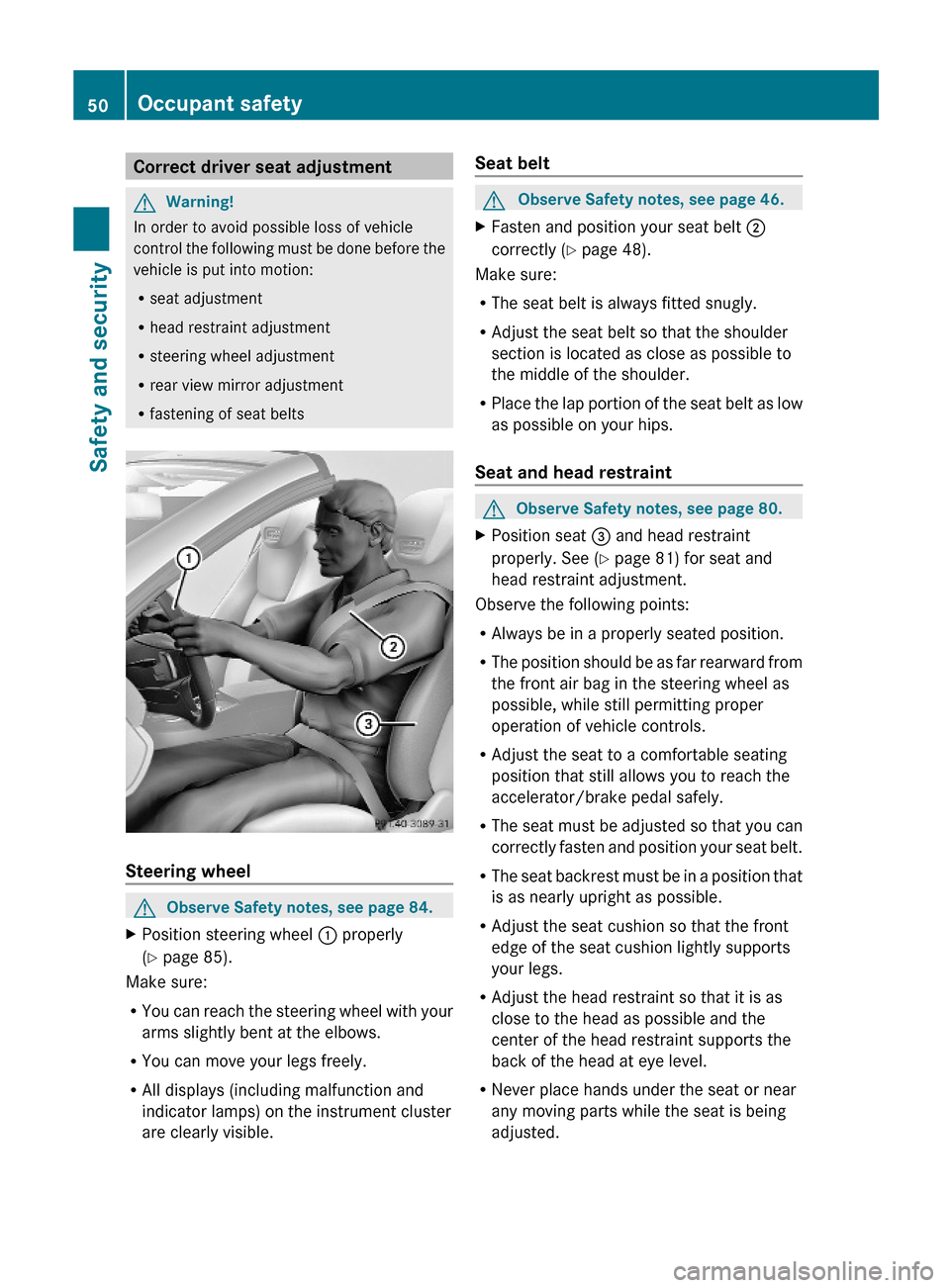
Correct driver seat adjustmentGWarning!
In order to avoid possible loss of vehicle
control the following must be done before the
vehicle is put into motion:
Rseat adjustment
Rhead restraint adjustment
Rsteering wheel adjustment
Rrear view mirror adjustment
Rfastening of seat belts
Steering wheel
GObserve Safety notes, see page 84.XPosition steering wheel : properly
(Y page 85).
Make sure:
RYou can reach the steering wheel with your
arms slightly bent at the elbows.
RYou can move your legs freely.
RAll displays (including malfunction and
indicator lamps) on the instrument cluster
are clearly visible.
Seat beltGObserve Safety notes, see page 46.XFasten and position your seat belt ;
correctly (Y page 48).
Make sure:
RThe seat belt is always fitted snugly.
RAdjust the seat belt so that the shoulder
section is located as close as possible to
the middle of the shoulder.
RPlace the lap portion of the seat belt as low
as possible on your hips.
Seat and head restraint
GObserve Safety notes, see page 80.XPosition seat = and head restraint
properly. See (Y page 81) for seat and
head restraint adjustment.
Observe the following points:
RAlways be in a properly seated position.
RThe position should be as far rearward from
the front air bag in the steering wheel as
possible, while still permitting proper
operation of vehicle controls.
RAdjust the seat to a comfortable seating
position that still allows you to reach the
accelerator/brake pedal safely.
RThe seat must be adjusted so that you can
correctly fasten and position your seat belt.
RThe seat backrest must be in a position that
is as nearly upright as possible.
RAdjust the seat cushion so that the front
edge of the seat cushion lightly supports
your legs.
RAdjust the head restraint so that it is as
close to the head as possible and the
center of the head restraint supports the
back of the head at eye level.
RNever place hands under the seat or near
any moving parts while the seat is being
adjusted.
50Occupant safetySafety and security
230_AKB; 6; 22, en-USd2ureepe,Version: 2.11.8.12009-07-28T18:49:58+02:00 - Seite 50
Page 53 of 316
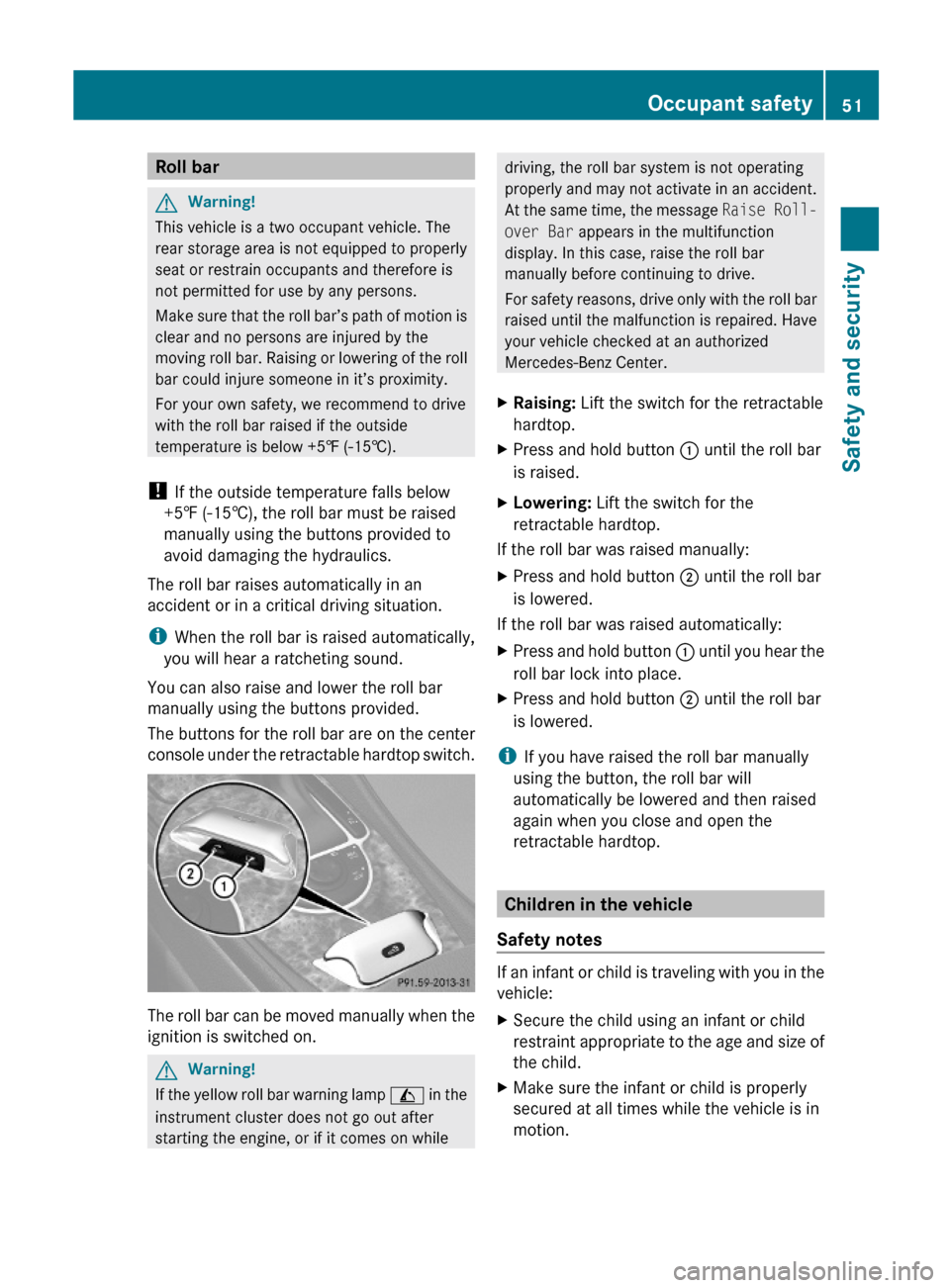
Roll barGWarning!
This vehicle is a two occupant vehicle. The
rear storage area is not equipped to properly
seat or restrain occupants and therefore is
not permitted for use by any persons.
Make sure that the roll bar’s path of motion is
clear and no persons are injured by the
moving roll bar. Raising or lowering of the roll
bar could injure someone in it’s proximity.
For your own safety, we recommend to drive
with the roll bar raised if the outside
temperature is below +5‡ (-15†).
! If the outside temperature falls below
+5‡ (-15†), the roll bar must be raised
manually using the buttons provided to
avoid damaging the hydraulics.
The roll bar raises automatically in an
accident or in a critical driving situation.
iWhen the roll bar is raised automatically,
you will hear a ratcheting sound.
You can also raise and lower the roll bar
manually using the buttons provided.
The buttons for the roll bar are on the center
console under the retractable hardtop switch.
The roll bar can be moved manually when the
ignition is switched on.
GWarning!
If the yellow roll bar warning lamp I in the
instrument cluster does not go out after
starting the engine, or if it comes on while
driving, the roll bar system is not operating
properly and may not activate in an accident.
At the same time, the message Raise Roll-
over Bar appears in the multifunction
display. In this case, raise the roll bar
manually before continuing to drive.
For safety reasons, drive only with the roll bar
raised until the malfunction is repaired. Have
your vehicle checked at an authorized
Mercedes-Benz Center.
XRaising: Lift the switch for the retractable
hardtop.
XPress and hold button : until the roll bar
is raised.
XLowering: Lift the switch for the
retractable hardtop.
If the roll bar was raised manually:
XPress and hold button ; until the roll bar
is lowered.
If the roll bar was raised automatically:
XPress and hold button : until you hear the
roll bar lock into place.
XPress and hold button ; until the roll bar
is lowered.
iIf you have raised the roll bar manually
using the button, the roll bar will
automatically be lowered and then raised
again when you close and open the
retractable hardtop.
Children in the vehicle
Safety notes
If an infant or child is traveling with you in the
vehicle:
XSecure the child using an infant or child
restraint appropriate to the age and size of
the child.
XMake sure the infant or child is properly
secured at all times while the vehicle is in
motion.
Occupant safety51Safety and security230_AKB; 6; 22, en-USd2ureepe,Version: 2.11.8.12009-07-28T18:49:58+02:00 - Seite 51Z
Page 57 of 316
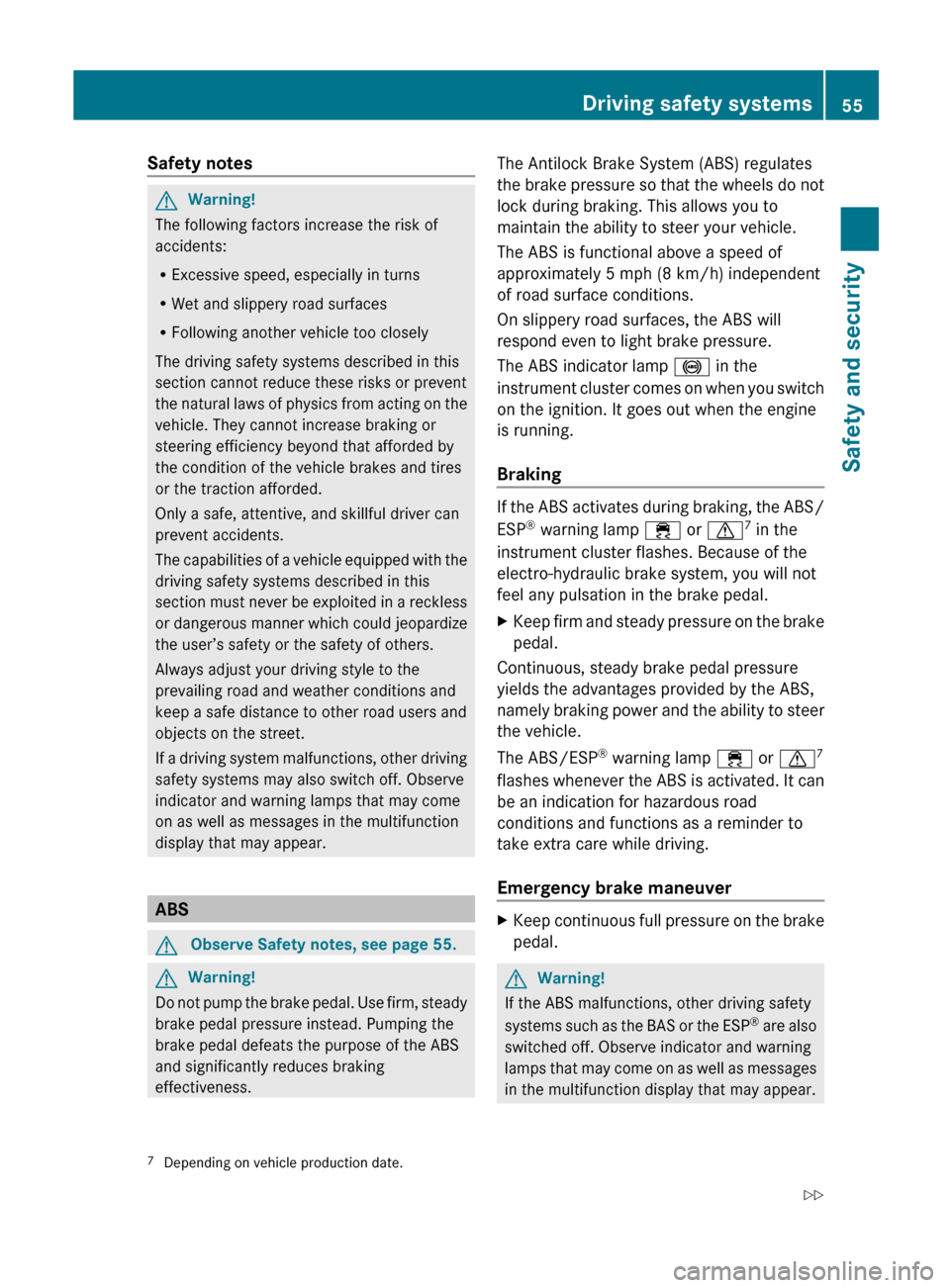
Safety notesGWarning!
The following factors increase the risk of
accidents:
R Excessive speed, especially in turns
R Wet and slippery road surfaces
R Following another vehicle too closely
The driving safety systems described in this
section cannot reduce these risks or prevent
the natural laws of physics from acting on the
vehicle. They cannot increase braking or
steering efficiency beyond that afforded by
the condition of the vehicle brakes and tires
or the traction afforded.
Only a safe, attentive, and skillful driver can
prevent accidents.
The capabilities of a vehicle equipped with the
driving safety systems described in this
section must never be exploited in a reckless
or dangerous manner which could jeopardize
the user’s safety or the safety of others.
Always adjust your driving style to the
prevailing road and weather conditions and
keep a safe distance to other road users and
objects on the street.
If a driving system malfunctions, other driving
safety systems may also switch off. Observe
indicator and warning lamps that may come
on as well as messages in the multifunction
display that may appear.
ABS
GObserve Safety notes, see page 55.GWarning!
Do not pump the brake pedal. Use firm, steady
brake pedal pressure instead. Pumping the
brake pedal defeats the purpose of the ABS
and significantly reduces braking
effectiveness.
The Antilock Brake System (ABS) regulates
the brake pressure so that the wheels do not
lock during braking. This allows you to
maintain the ability to steer your vehicle.
The ABS is functional above a speed of
approximately 5 mph (8 km/h) independent
of road surface conditions.
On slippery road surfaces, the ABS will
respond even to light brake pressure.
The ABS indicator lamp ! in the
instrument cluster comes on when you switch
on the ignition. It goes out when the engine
is running.
Braking
If the ABS activates during braking, the ABS/
ESP ®
warning lamp ÷ or d 7
in the
instrument cluster flashes. Because of the
electro-hydraulic brake system, you will not
feel any pulsation in the brake pedal.
XKeep firm and steady pressure on the brake
pedal.
Continuous, steady brake pedal pressure
yields the advantages provided by the ABS,
namely braking power and the ability to steer
the vehicle.
The ABS/ESP ®
warning lamp ÷ or d 7
flashes whenever the ABS is activated. It can
be an indication for hazardous road
conditions and functions as a reminder to
take extra care while driving.
Emergency brake maneuver
XKeep continuous full pressure on the brake
pedal.GWarning!
If the ABS malfunctions, other driving safety
systems such as the BAS or the ESP ®
are also
switched off. Observe indicator and warning
lamps that may come on as well as messages
in the multifunction display that may appear.
7 Depending on vehicle production date.Driving safety systems55Safety and security230_AKB; 6; 22, en-USd2ureepe,Version: 2.11.8.12009-07-28T18:49:58+02:00 - Seite 55Z
Page 61 of 316
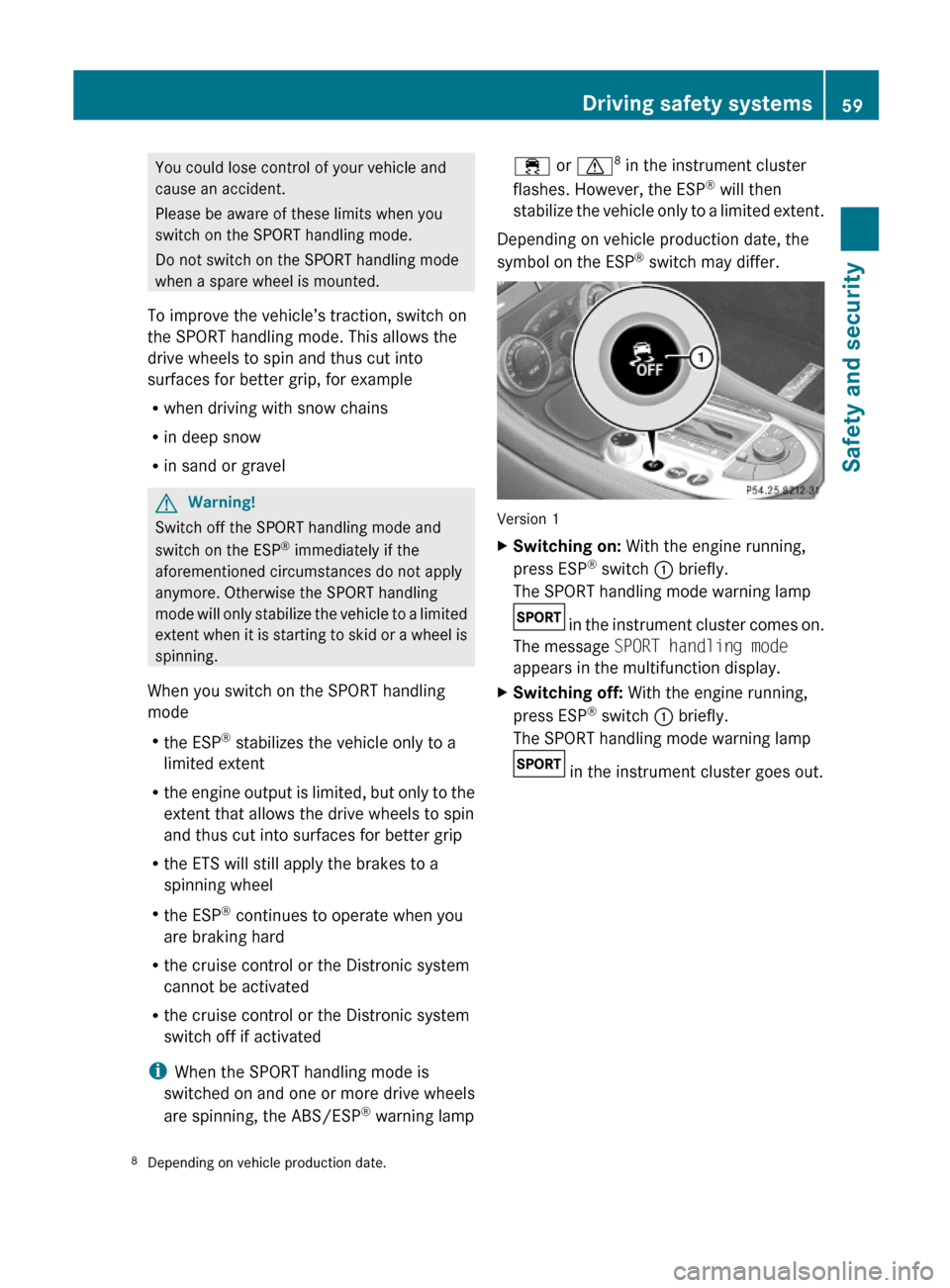
You could lose control of your vehicle and
cause an accident.
Please be aware of these limits when you
switch on the SPORT handling mode.
Do not switch on the SPORT handling mode
when a spare wheel is mounted.
To improve the vehicle’s traction, switch on
the SPORT handling mode. This allows the
drive wheels to spin and thus cut into
surfaces for better grip, for example
Rwhen driving with snow chains
Rin deep snow
Rin sand or gravel
GWarning!
Switch off the SPORT handling mode and
switch on the ESP® immediately if the
aforementioned circumstances do not apply
anymore. Otherwise the SPORT handling
mode will only stabilize the vehicle to a limited
extent when it is starting to skid or a wheel is
spinning.
When you switch on the SPORT handling
mode
Rthe ESP® stabilizes the vehicle only to a
limited extent
Rthe engine output is limited, but only to the
extent that allows the drive wheels to spin
and thus cut into surfaces for better grip
Rthe ETS will still apply the brakes to a
spinning wheel
Rthe ESP® continues to operate when you
are braking hard
Rthe cruise control or the Distronic system
cannot be activated
Rthe cruise control or the Distronic system
switch off if activated
iWhen the SPORT handling mode is
switched on and one or more drive wheels
are spinning, the ABS/ESP® warning lamp
÷ or d8 in the instrument cluster
flashes. However, the ESP® will then
stabilize the vehicle only to a limited extent.
Depending on vehicle production date, the
symbol on the ESP® switch may differ.
Version 1
XSwitching on: With the engine running,
press ESP® switch : briefly.
The SPORT handling mode warning lamp
in the instrument cluster comes on.
The message SPORT handling mode
appears in the multifunction display.
XSwitching off: With the engine running,
press ESP® switch : briefly.
The SPORT handling mode warning lamp
in the instrument cluster goes out.
8Depending on vehicle production date.Driving safety systems59Safety and security230_AKB; 6; 22, en-USd2ureepe,Version: 2.11.8.12009-07-28T18:49:58+02:00 - Seite 59Z
Page 62 of 316
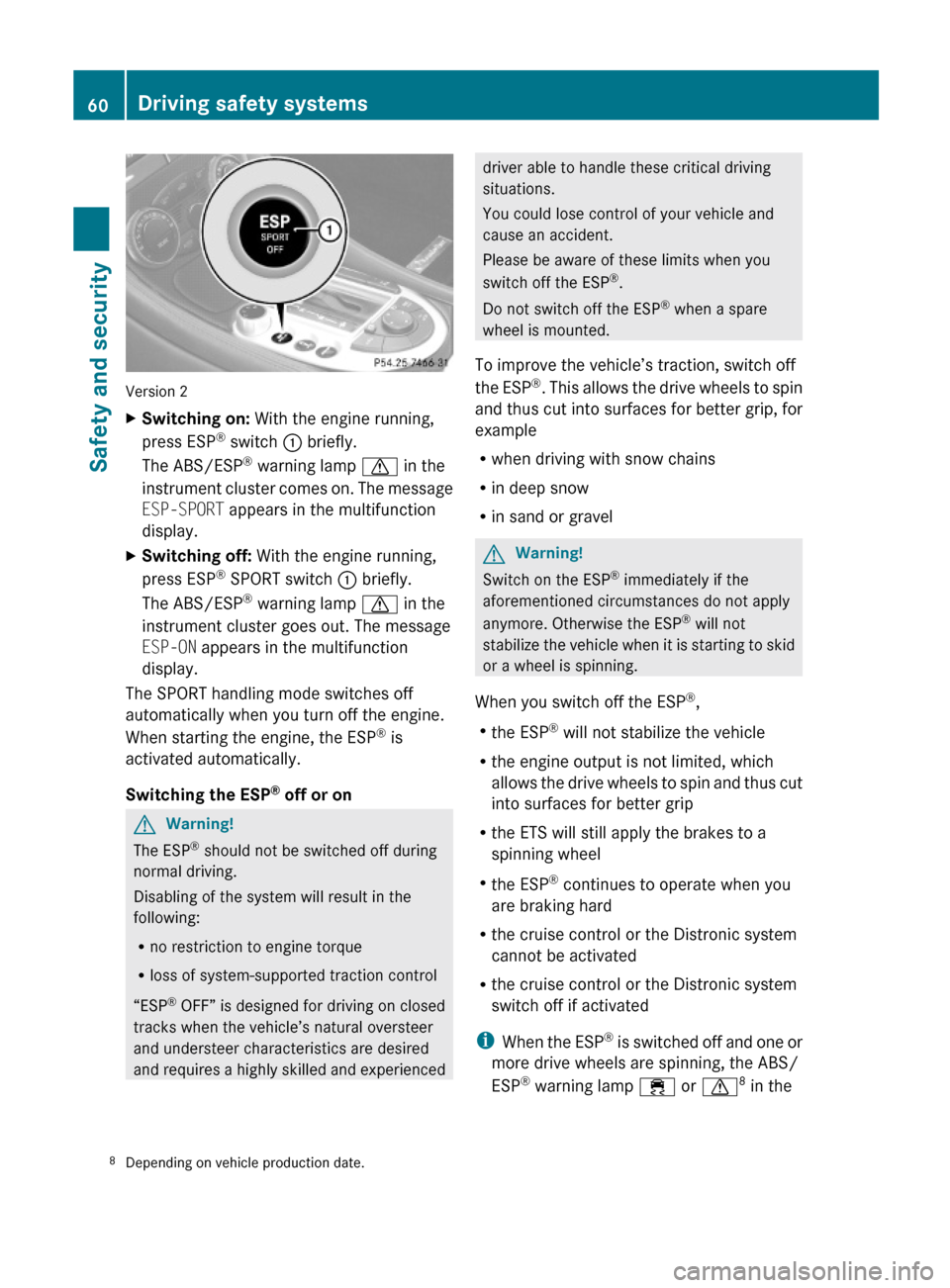
Version 2
XSwitching on: With the engine running,
press ESP® switch : briefly.
The ABS/ESP® warning lamp d in the
instrument cluster comes on. The message
ESP-SPORT appears in the multifunction
display.
XSwitching off: With the engine running,
press ESP® SPORT switch : briefly.
The ABS/ESP® warning lamp d in the
instrument cluster goes out. The message
ESP-ON appears in the multifunction
display.
The SPORT handling mode switches off
automatically when you turn off the engine.
When starting the engine, the ESP® is
activated automatically.
Switching the ESP® off or on
GWarning!
The ESP® should not be switched off during
normal driving.
Disabling of the system will result in the
following:
Rno restriction to engine torque
Rloss of system-supported traction control
“ESP® OFF” is designed for driving on closed
tracks when the vehicle’s natural oversteer
and understeer characteristics are desired
and requires a highly skilled and experienced
driver able to handle these critical driving
situations.
You could lose control of your vehicle and
cause an accident.
Please be aware of these limits when you
switch off the ESP®.
Do not switch off the ESP® when a spare
wheel is mounted.
To improve the vehicle’s traction, switch off
the ESP®. This allows the drive wheels to spin
and thus cut into surfaces for better grip, for
example
Rwhen driving with snow chains
Rin deep snow
Rin sand or gravel
GWarning!
Switch on the ESP® immediately if the
aforementioned circumstances do not apply
anymore. Otherwise the ESP® will not
stabilize the vehicle when it is starting to skid
or a wheel is spinning.
When you switch off the ESP®,
Rthe ESP® will not stabilize the vehicle
Rthe engine output is not limited, which
allows the drive wheels to spin and thus cut
into surfaces for better grip
Rthe ETS will still apply the brakes to a
spinning wheel
Rthe ESP® continues to operate when you
are braking hard
Rthe cruise control or the Distronic system
cannot be activated
Rthe cruise control or the Distronic system
switch off if activated
iWhen the ESP® is switched off and one or
more drive wheels are spinning, the ABS/
ESP® warning lamp ÷ or d8 in the
8Depending on vehicle production date.60Driving safety systemsSafety and security
230_AKB; 6; 22, en-USd2ureepe,Version: 2.11.8.12009-07-28T18:49:58+02:00 - Seite 60
Page 63 of 316
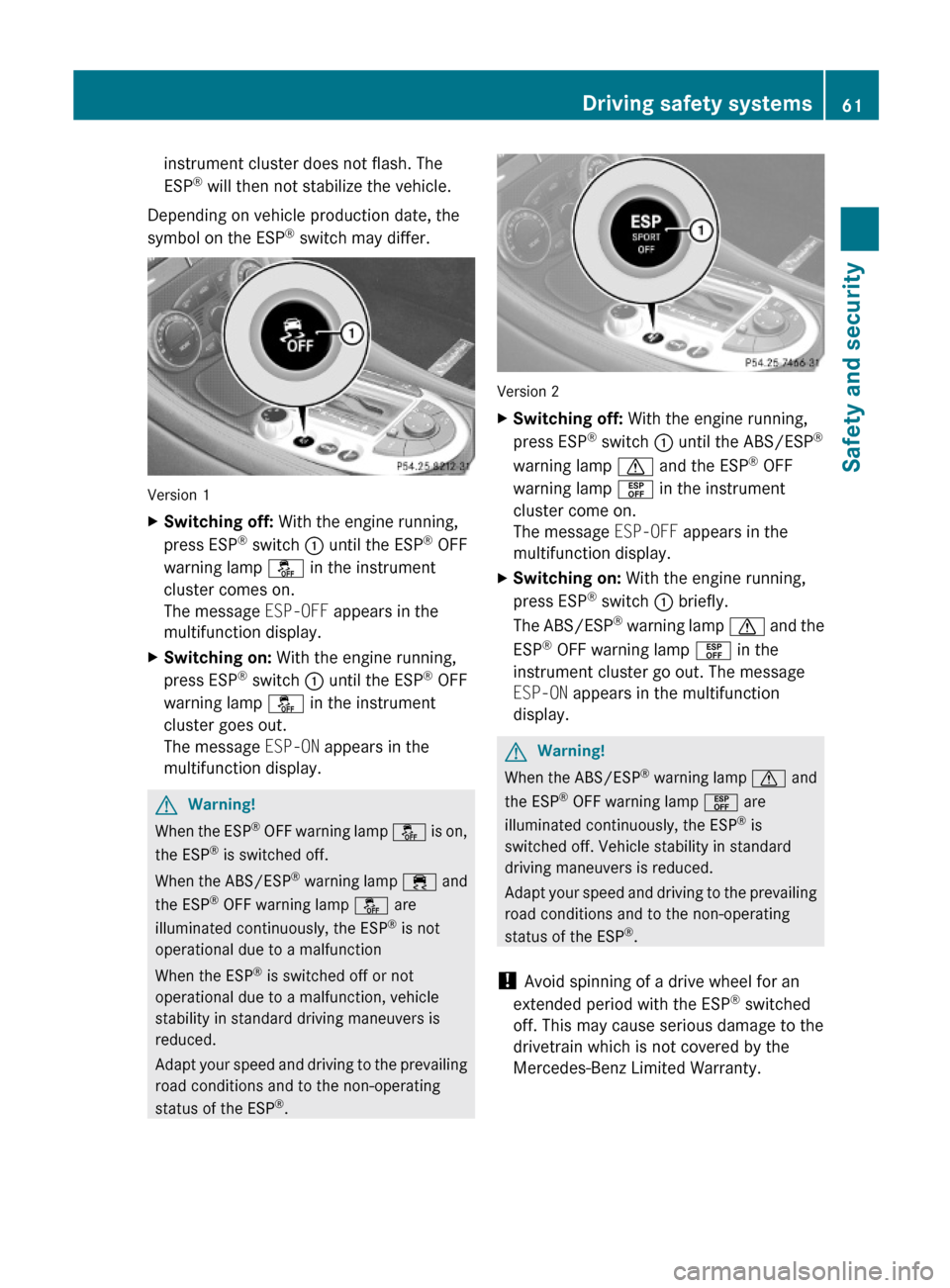
instrument cluster does not flash. The
ESP® will then not stabilize the vehicle.
Depending on vehicle production date, the
symbol on the ESP® switch may differ.
Version 1
XSwitching off: With the engine running,
press ESP® switch : until the ESP® OFF
warning lamp å in the instrument
cluster comes on.
The message ESP-OFF appears in the
multifunction display.
XSwitching on: With the engine running,
press ESP® switch : until the ESP® OFF
warning lamp å in the instrument
cluster goes out.
The message ESP-ON appears in the
multifunction display.
GWarning!
When the ESP® OFF warning lamp å is on,
the ESP® is switched off.
When the ABS/ESP® warning lamp ÷ and
the ESP® OFF warning lamp å are
illuminated continuously, the ESP® is not
operational due to a malfunction
When the ESP® is switched off or not
operational due to a malfunction, vehicle
stability in standard driving maneuvers is
reduced.
Adapt your speed and driving to the prevailing
road conditions and to the non-operating
status of the ESP®.
Version 2
XSwitching off: With the engine running,
press ESP® switch : until the ABS/ESP®
warning lamp d and the ESP® OFF
warning lamp % in the instrument
cluster come on.
The message ESP-OFF appears in the
multifunction display.
XSwitching on: With the engine running,
press ESP® switch : briefly.
The ABS/ESP® warning lamp d and the
ESP® OFF warning lamp % in the
instrument cluster go out. The message
ESP-ON appears in the multifunction
display.
GWarning!
When the ABS/ESP® warning lamp d and
the ESP® OFF warning lamp % are
illuminated continuously, the ESP® is
switched off. Vehicle stability in standard
driving maneuvers is reduced.
Adapt your speed and driving to the prevailing
road conditions and to the non-operating
status of the ESP®.
! Avoid spinning of a drive wheel for an
extended period with the ESP® switched
off. This may cause serious damage to the
drivetrain which is not covered by the
Mercedes-Benz Limited Warranty.
Driving safety systems61Safety and security230_AKB; 6; 22, en-USd2ureepe,Version: 2.11.8.12009-07-28T18:49:58+02:00 - Seite 61Z
Page 64 of 316
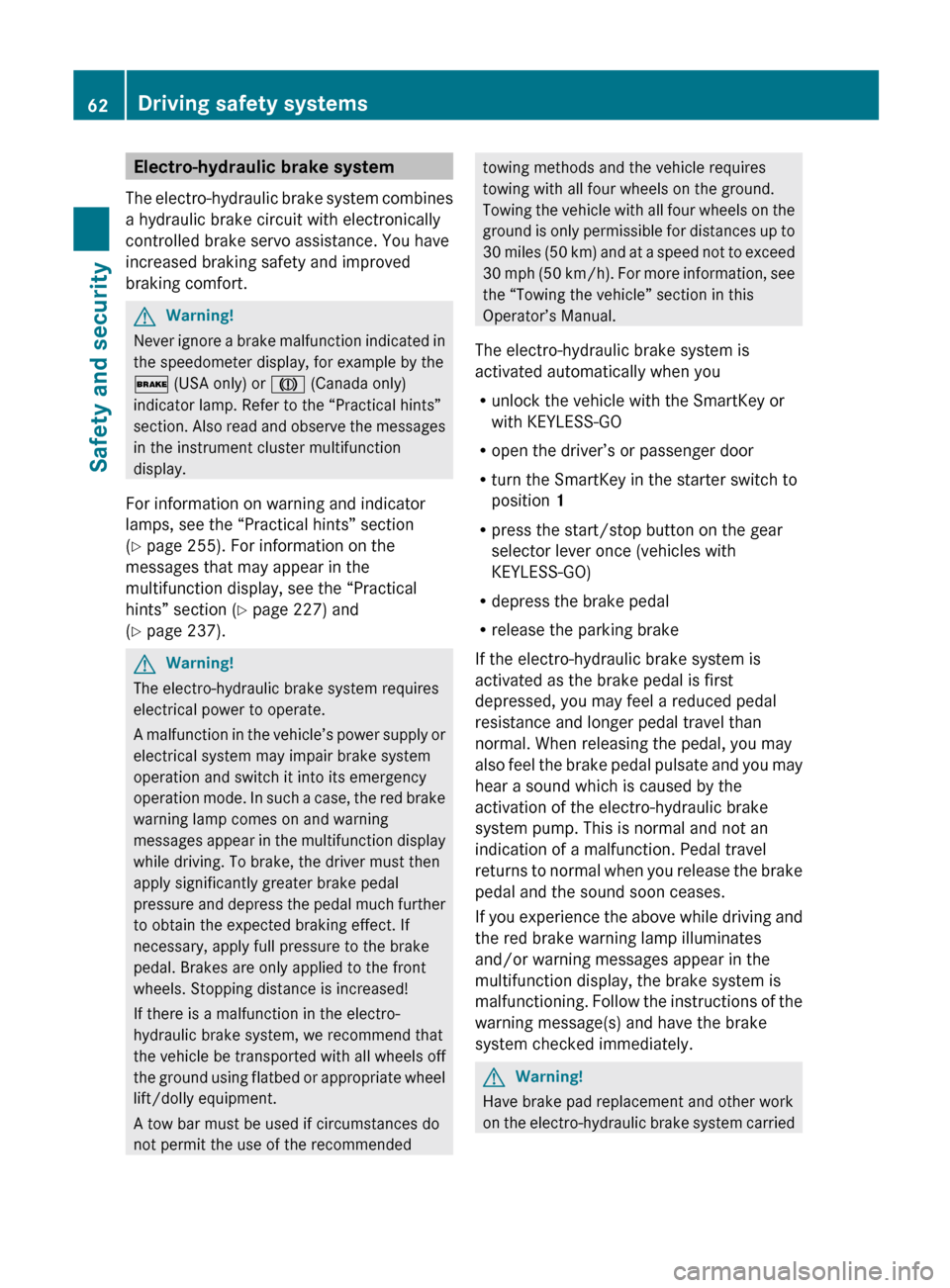
Electro-hydraulic brake system
The electro-hydraulic brake system combines
a hydraulic brake circuit with electronically
controlled brake servo assistance. You have
increased braking safety and improved
braking comfort.GWarning!
Never ignore a brake malfunction indicated in
the speedometer display, for example by the
$ (USA only) or J (Canada only)
indicator lamp. Refer to the “Practical hints”
section. Also read and observe the messages
in the instrument cluster multifunction
display.
For information on warning and indicator
lamps, see the “Practical hints” section
( Y page 255). For information on the
messages that may appear in the
multifunction display, see the “Practical
hints” section ( Y page 227) and
( Y page 237).
GWarning!
The electro-hydraulic brake system requires
electrical power to operate.
A malfunction in the vehicle’s power supply or
electrical system may impair brake system
operation and switch it into its emergency
operation mode. In such a case, the red brake
warning lamp comes on and warning
messages appear in the multifunction display
while driving. To brake, the driver must then
apply significantly greater brake pedal
pressure and depress the pedal much further
to obtain the expected braking effect. If
necessary, apply full pressure to the brake
pedal. Brakes are only applied to the front
wheels. Stopping distance is increased!
If there is a malfunction in the electro-
hydraulic brake system, we recommend that
the vehicle be transported with all wheels off
the ground using flatbed or appropriate wheel
lift/dolly equipment.
A tow bar must be used if circumstances do
not permit the use of the recommended
towing methods and the vehicle requires
towing with all four wheels on the ground.
Towing the vehicle with all four wheels on the
ground is only permissible for distances up to
30 miles (50 km) and at a speed not to exceed
30 mph (50 km/h). For more information, see
the “Towing the vehicle” section in this
Operator’s Manual.
The electro-hydraulic brake system is
activated automatically when you
R unlock the vehicle with the SmartKey or
with KEYLESS-GO
R open the driver’s or passenger door
R turn the SmartKey in the starter switch to
position 1
R press the start/stop button on the gear
selector lever once (vehicles with
KEYLESS-GO)
R depress the brake pedal
R release the parking brake
If the electro-hydraulic brake system is
activated as the brake pedal is first
depressed, you may feel a reduced pedal
resistance and longer pedal travel than
normal. When releasing the pedal, you may
also feel the brake pedal pulsate and you may
hear a sound which is caused by the
activation of the electro-hydraulic brake
system pump. This is normal and not an
indication of a malfunction. Pedal travel
returns to normal when you release the brake
pedal and the sound soon ceases.
If you experience the above while driving and
the red brake warning lamp illuminates
and/or warning messages appear in the
multifunction display, the brake system is
malfunctioning. Follow the instructions of the
warning message(s) and have the brake
system checked immediately.GWarning!
Have brake pad replacement and other work
on the electro-hydraulic brake system carried
62Driving safety systemsSafety and security
230_AKB; 6; 22, en-USd2ureepe,Version: 2.11.8.12009-07-28T18:49:58+02:00 - Seite 62
Page 72 of 316
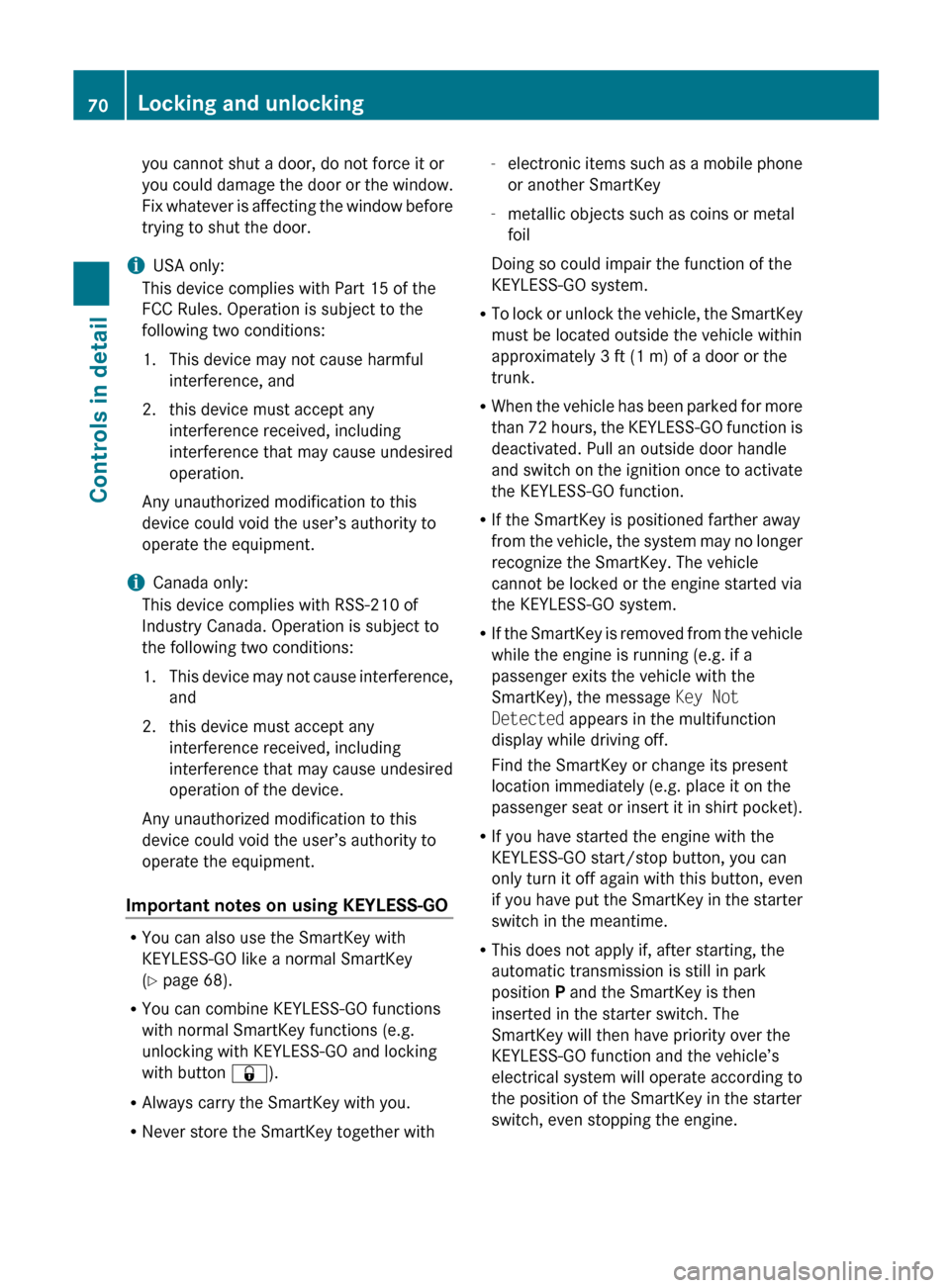
you cannot shut a door, do not force it or
you could damage the door or the window.
Fix whatever is affecting the window before
trying to shut the door.
i USA only:
This device complies with Part 15 of the
FCC Rules. Operation is subject to the
following two conditions:
1. This device may not cause harmful interference, and
2. this device must accept any interference received, including
interference that may cause undesired
operation.
Any unauthorized modification to this
device could void the user’s authority to
operate the equipment.
i Canada only:
This device complies with RSS-210 of
Industry Canada. Operation is subject to
the following two conditions:
1. This device may not cause interference,
and
2. this device must accept any interference received, including
interference that may cause undesired
operation of the device.
Any unauthorized modification to this
device could void the user’s authority to
operate the equipment.
Important notes on using KEYLESS-GO
R You can also use the SmartKey with
KEYLESS-GO like a normal SmartKey
( Y page 68).
R You can combine KEYLESS-GO functions
with normal SmartKey functions (e.g.
unlocking with KEYLESS-GO and locking
with button &).
R Always carry the SmartKey with you.
R Never store the SmartKey together with
-electronic items such as a mobile phone
or another SmartKey
- metallic objects such as coins or metal
foil
Doing so could impair the function of the
KEYLESS-GO system.
R To lock or unlock the vehicle, the SmartKey
must be located outside the vehicle within
approximately 3 ft (1 m) of a door or the
trunk.
R When the vehicle has been parked for more
than 72 hours, the KEYLESS-GO function is
deactivated. Pull an outside door handle
and switch on the ignition once to activate
the KEYLESS-GO function.
R If the SmartKey is positioned farther away
from the vehicle, the system may no longer
recognize the SmartKey. The vehicle
cannot be locked or the engine started via
the KEYLESS-GO system.
R If the SmartKey is removed from the vehicle
while the engine is running (e.g. if a
passenger exits the vehicle with the
SmartKey), the message Key Not
Detected appears in the multifunction
display while driving off.
Find the SmartKey or change its present
location immediately (e.g. place it on the
passenger seat or insert it in shirt pocket).
R If you have started the engine with the
KEYLESS-GO start/stop button, you can
only turn it off again with this button, even
if you have put the SmartKey in the starter
switch in the meantime.
R This does not apply if, after starting, the
automatic transmission is still in park
position P and the SmartKey is then
inserted in the starter switch. The
SmartKey will then have priority over the
KEYLESS-GO function and the vehicle’s
electrical system will operate according to
the position of the SmartKey in the starter
switch, even stopping the engine.70Locking and unlockingControls in detail
230_AKB; 6; 22, en-USd2ureepe,Version: 2.11.8.12009-07-28T18:49:58+02:00 - Seite 70
Page 73 of 316
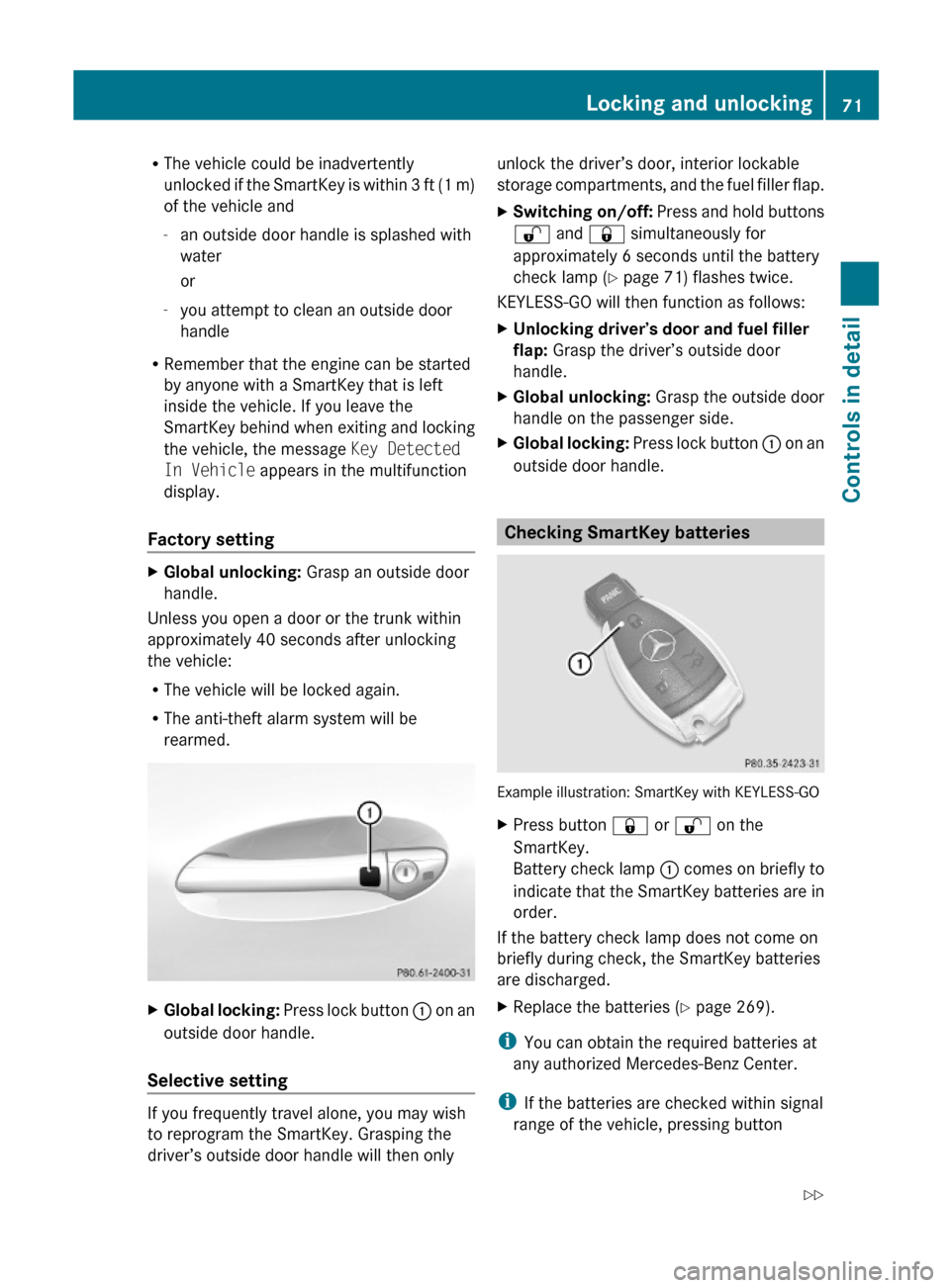
RThe vehicle could be inadvertently
unlocked if the SmartKey is within 3 ft (1 m)
of the vehicle and
-an outside door handle is splashed with
water
or
-you attempt to clean an outside door
handle
RRemember that the engine can be started
by anyone with a SmartKey that is left
inside the vehicle. If you leave the
SmartKey behind when exiting and locking
the vehicle, the message Key Detected
In Vehicle appears in the multifunction
display.
Factory setting
XGlobal unlocking: Grasp an outside door
handle.
Unless you open a door or the trunk within
approximately 40 seconds after unlocking
the vehicle:
RThe vehicle will be locked again.
RThe anti-theft alarm system will be
rearmed.
XGlobal locking: Press lock button : on an
outside door handle.
Selective setting
If you frequently travel alone, you may wish
to reprogram the SmartKey. Grasping the
driver’s outside door handle will then only
unlock the driver’s door, interior lockable
storage compartments, and the fuel filler flap.
XSwitching on/off: Press and hold buttons
% and & simultaneously for
approximately 6 seconds until the battery
check lamp (Y page 71) flashes twice.
KEYLESS-GO will then function as follows:
XUnlocking driver’s door and fuel filler
flap: Grasp the driver’s outside door
handle.
XGlobal unlocking: Grasp the outside door
handle on the passenger side.
XGlobal locking: Press lock button : on an
outside door handle.
Checking SmartKey batteries
Example illustration: SmartKey with KEYLESS-GO
XPress button & or % on the
SmartKey.
Battery check lamp : comes on briefly to
indicate that the SmartKey batteries are in
order.
If the battery check lamp does not come on
briefly during check, the SmartKey batteries
are discharged.
XReplace the batteries (Y page 269).
iYou can obtain the required batteries at
any authorized Mercedes-Benz Center.
iIf the batteries are checked within signal
range of the vehicle, pressing button
Locking and unlocking71Controls in detail230_AKB; 6; 22, en-USd2ureepe,Version: 2.11.8.12009-07-28T18:49:58+02:00 - Seite 71Z
Page 86 of 316
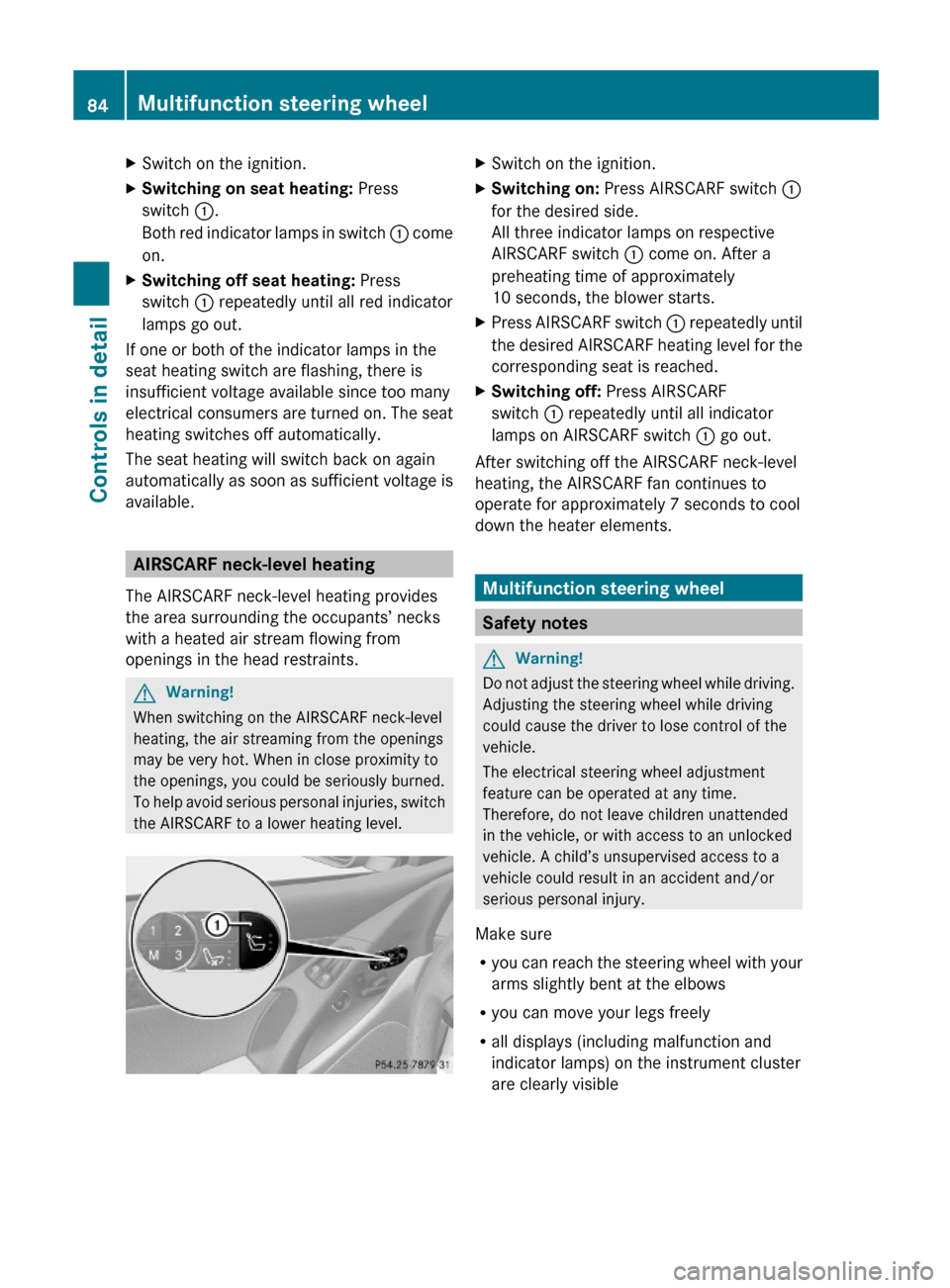
XSwitch on the ignition.XSwitching on seat heating: Press
switch :.
Both red indicator lamps in switch : come
on.
XSwitching off seat heating: Press
switch : repeatedly until all red indicator
lamps go out.
If one or both of the indicator lamps in the
seat heating switch are flashing, there is
insufficient voltage available since too many
electrical consumers are turned on. The seat
heating switches off automatically.
The seat heating will switch back on again
automatically as soon as sufficient voltage is
available.
AIRSCARF neck-level heating
The AIRSCARF neck-level heating provides
the area surrounding the occupants’ necks
with a heated air stream flowing from
openings in the head restraints.
GWarning!
When switching on the AIRSCARF neck-level
heating, the air streaming from the openings
may be very hot. When in close proximity to
the openings, you could be seriously burned.
To help avoid serious personal injuries, switch
the AIRSCARF to a lower heating level.
XSwitch on the ignition.XSwitching on: Press AIRSCARF switch :
for the desired side.
All three indicator lamps on respective
AIRSCARF switch : come on. After a
preheating time of approximately
10 seconds, the blower starts.
XPress AIRSCARF switch : repeatedly until
the desired AIRSCARF heating level for the
corresponding seat is reached.
XSwitching off: Press AIRSCARF
switch : repeatedly until all indicator
lamps on AIRSCARF switch : go out.
After switching off the AIRSCARF neck-level
heating, the AIRSCARF fan continues to
operate for approximately 7 seconds to cool
down the heater elements.
Multifunction steering wheel
Safety notes
GWarning!
Do not adjust the steering wheel while driving.
Adjusting the steering wheel while driving
could cause the driver to lose control of the
vehicle.
The electrical steering wheel adjustment
feature can be operated at any time.
Therefore, do not leave children unattended
in the vehicle, or with access to an unlocked
vehicle. A child’s unsupervised access to a
vehicle could result in an accident and/or
serious personal injury.
Make sure
Ryou can reach the steering wheel with your
arms slightly bent at the elbows
Ryou can move your legs freely
Rall displays (including malfunction and
indicator lamps) on the instrument cluster
are clearly visible
84Multifunction steering wheelControls in detail
230_AKB; 6; 22, en-USd2ureepe,Version: 2.11.8.12009-07-28T18:49:58+02:00 - Seite 84